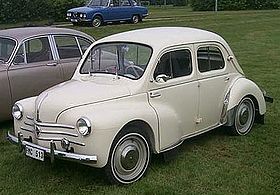| Renault 4CV | |
|---|---|
 | |
| Overview | |
| Manufacturer | Renault |
| Also called | Hino 4CV Renault 4/4 Renault 760 Renault 750 Renault Quintette[1] |
| Production | 1947–1961 1,105,543 produced[2] |
| Assembly | Billancourt, France Sydney, Australia[3] Acton, England[4] Hino-shi, Japan Valladolid, Spain Nesher, Israel |
| Body and chassis | |
| Class | Supermini |
| Body style | 4-door saloon car 4-door cabriolet 4-door panel van[1] |
| Layout | RR layout |
| Powertrain | |
| Engine | 760 cc Renault I4 engine 747 cc Renault I4 engine |
| Transmission | 3-speed manual |
| Dimensions | |
| Length | 3,663 mm (144.2 in) |
| Width | 1,430 mm (56.3 in) |
| Height | 1,470 mm (57.9 in) |
| Curb weight | 620 kg (1,367 lb) |
| Chronology | |
| Predecessor | Renault Juvaquatre |
| Successor | Renault Dauphine Renault 4 |
The Renault 4CV (French: quatre chevaux, pronounced [kat.ʃəvo] as if spelled quat'chevaux)[5] is a car produced by the French company Renault from August 1947 through July 1961.[2] It is a four-door economy car with its engine mounted in the rear and driving the rear wheels. It was the first French car to sell over a million units, and was superseded by the Dauphine.
The 4CV was of monocoque construction,[2] 3.6 m (11 ft 10 in) in length with front suicide doors.[6]
CV is the abbreviation of chevaux-vapeur, the French equivalent to "horsepower" as a unit of power. The name 4CV thus refers to the car's tax horsepower.
- ^ a b 1952 Renault US 4CV 750 Quintette Sedan Convertible Panel Deliv. Brochure wu0610, www.ebay.co.uk, as archived at web.archive.org
- ^ a b c Cite error: The named reference
AutoMotoruSport197713was invoked but never defined (see the help page). - ^ The Renault 4CV (750) In Australia, Restored Cars Number 202, Sep-Oct 2010, pages 38-39
- ^ "Our history in the UK". Renault. Retrieved 30 July 2017.
- ^ Malherbe, M.V. (1725). La langue françoise,: expliquée dans un ordre nouveau, ou l'on trouve des principes certains sur toutes les parties du discours. Plusieurs lettres choisies, tirées des meilleurs auteurs, avec des remarques critiques & un abregé de la versification. p. 6.
- ^ "Motoring Memories: Renault 4CV, 1947-1961, by Bill Vance". Canadian Driver. April 18, 2008.